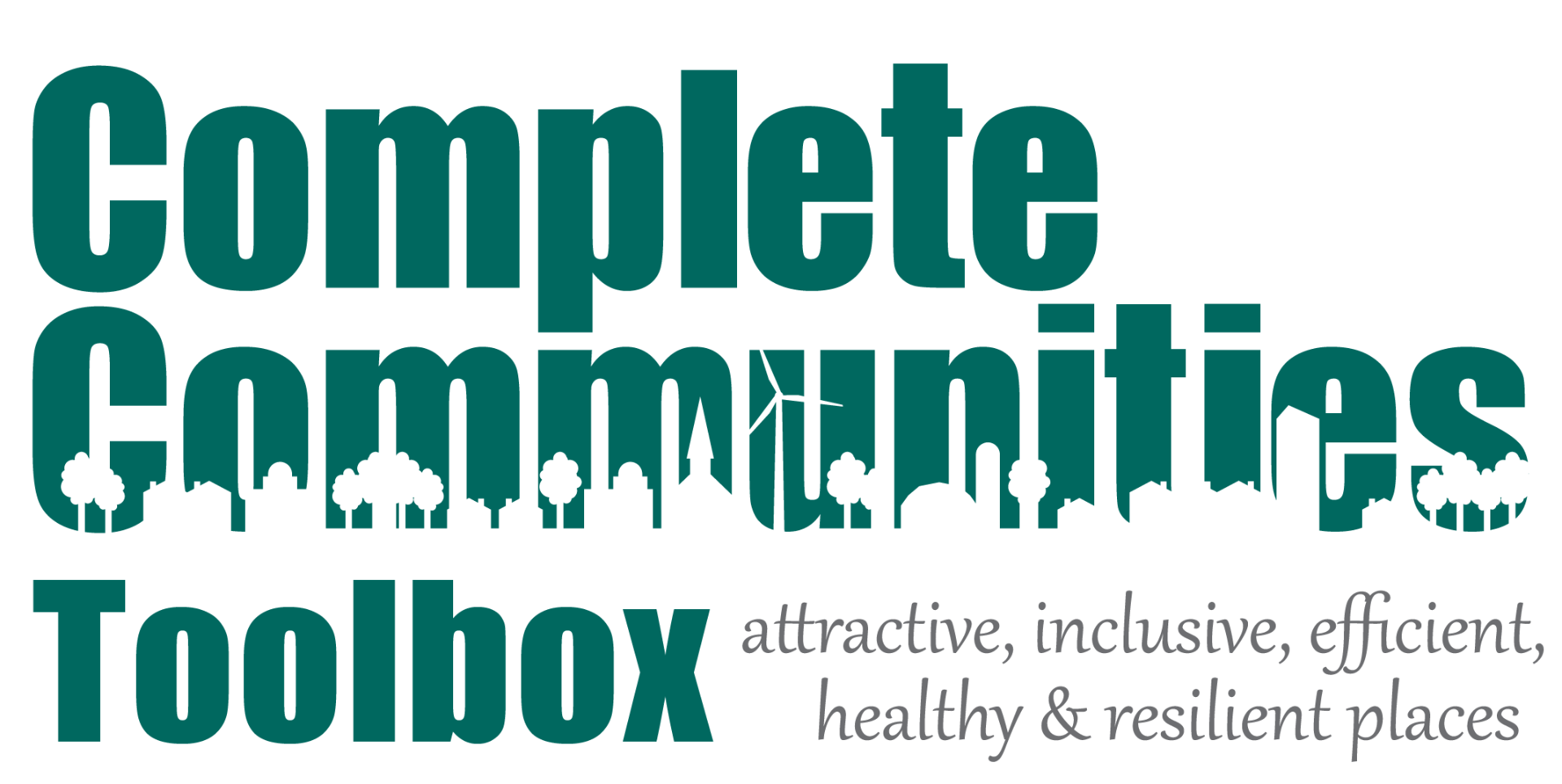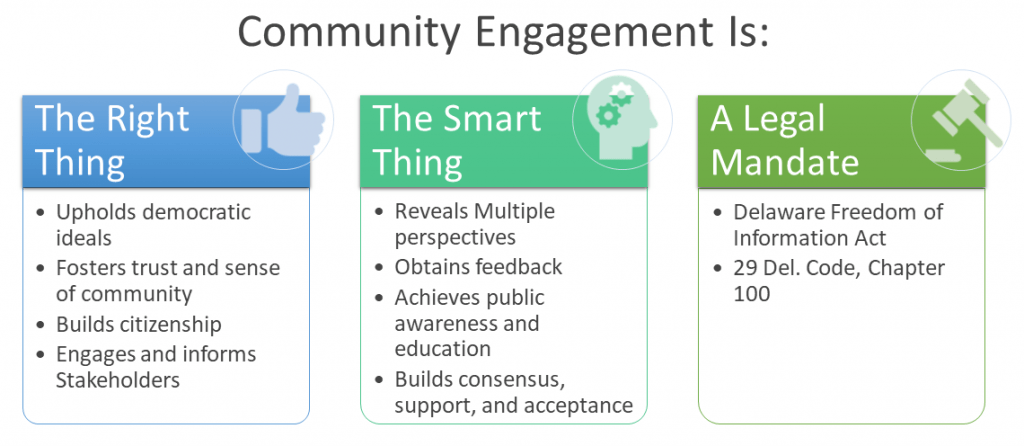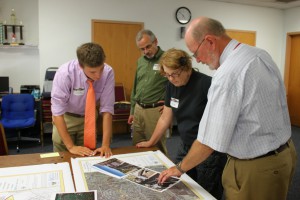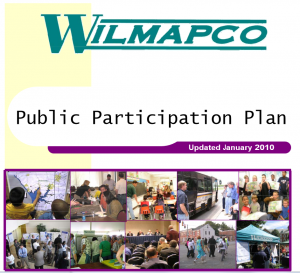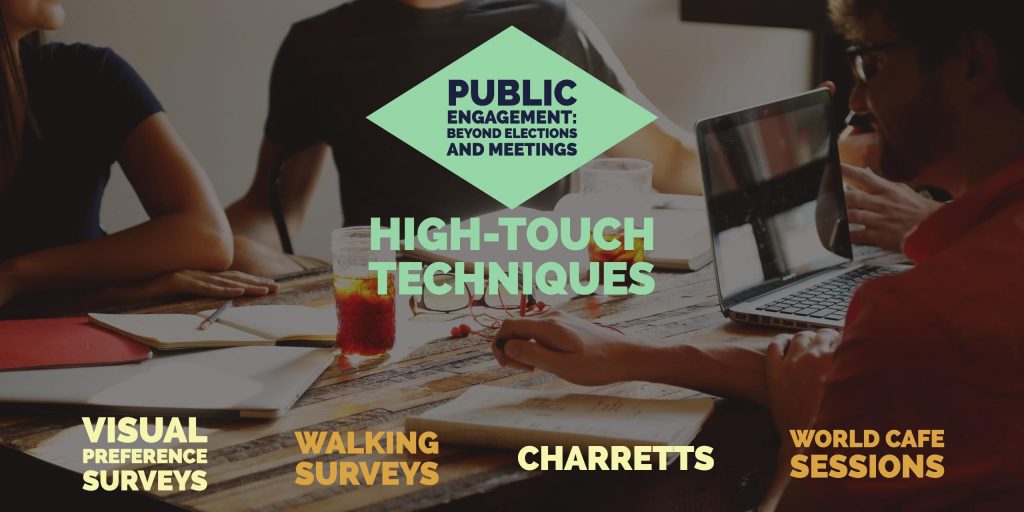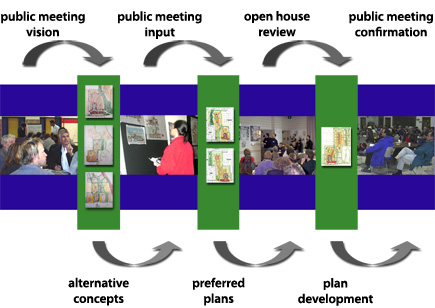Public engagement involves much more than just public participation at public hearings, council meetings, or workshops. Local governments need to understand the benefits of citizen engagement, develop public engagement plans, and provide opportunities that create meaningful public involvement. Engaging residents and other stakeholders can increase understanding, create better and sustainable decisions, and build trust. This section offers a variety of tools and techniques to more effectively build public engagement using a combination of high-touch, high-tech community techniques.
Topics:
- What is Public Engagement?
- Why Public Engagement is Important to Building Complete Communities
- Benefits of Public Engagement
- What is a Public Engagement Plan?
- High-Touch Public Engagement
- High-Tech Public Engagement
- An Integrated Approach to Public Engagement
- Best Practices
- Tools and Resources for Public Engagement
What is Public Engagement?
While there is not one definition of community engagement, it can be described a deliberative process through which citizens and stakeholders come together to engage in thoughtful discussion, express their points of view, and discover common ground to influence government decision making.
Community engagement is an expansion of democratic practice that goes beyond citizens’ voting in elections or showing up at meetings. It is most effective when strategies are planned, the process is authentic, citizens feel their input is valued, and the process results in informed decision making.
Legal Basis for Public Involvement
Public engagement is both the right and smart thing to do. In addition, federal and state Freedom of Information Acts, commonly called “sunshine laws,” mandate the process.
Why is Public Engagement Needed?
Community engagement is important for local governments because it involves citizens in good governance. It also increases legitimacy, efficiency, and accountability of decision making. There is no single best way to achieve engagement, or one technique or format that serves all engagement purposes. Public engagement methods may be conventional “high-touch” participatory processes (such as task forces, public meetings, workshops, and focus groups) that involve face-to-face interaction. High-tech approaches involve the dissemination of information through electronic networks, social media, and new technology. The most effective strategies integrate high-touch and high-tech approaches to sustain engagement, involve diverse stakeholders, and incorporate a wide range of activities and techniques.
Why is Public Engagement Important to Building Complete Communities?
It is Essential to Complete Communities
According to research conducted by IPA, inclusive and active is one of the five elements of a complete community. Complete communities actively seek to engage citizens and strengthen their involvement in community visioning and planning, creating durable social networks, and preserving the culture of a community.
of a community.
Public participation strengthens and is an integral part of decision-making process at the federal, state, and local government levels. Early and continuous public involvement ensures that decisions reflect public needs and interests, consider diverse viewpoints and values, and are made in collaboration and consensus with all stakeholders. This process builds mutual understanding and trust between government entities and the people they serve. Successful public participation is a deliberate and continuous process. It consists of a series of activities and actions, and serves to inform, educate, and gain input from stakeholders on decisions that affect their lives.
It Meets Federal Mandates
The federal Freedom of Information Act (FOIA) was enacted ensure an informed citizenry, which is vital to the functioning of a democratic society. It encourages federal agency accountability through transparency by providing access to public records and decision-making processes. For example, federal transportation laws and regulations provide general guidelines for locally developed public involvement processes and procedures. With respect to transportation planning, state departments of transportation, metropolitan planning organizations (MPOs), and public transit agencies are required to:
1) Develop and use a documented public involvement process that provides reasonable opportunities for public review and comment,
2) Provide a reasonable opportunity for the public to comment on the proposed plan, and
3) Adopt strategies to target under-represented, under-served, and/or special-needs audiences.
It Conforms to State Laws
State “sunshine laws” guarantee that all meetings of a public body are open to the public and there is access to the public records of governmental bodies. Delaware’s FOIA states that “it is vital in a democratic society that public business be performed in an open and public manner” and that “citizens have easy access to public records.” All meetings of any public body in Delaware—including local town or county councils, planning commissions, and boards of adjustment—must be advertised, open, and accessible to the public.
Delaware also has a strong tradition of involving citizens in land-use decisions. The Delaware Code requires local governments to establish Planning Commissions, which serve in either a decision-making or an advisory capacity to the local legislative body. Volunteer boards, commissions, and committees work to build consensus on land or transportation plans, promote smart growth, protect the environment, and enhance the economy.
Benefits of Community Engagement
“The positive outcomes of constructive collaboration are numerous, and far outweigh the potential challenges of coordinating such an effort. Not only are the chances better for program success, but residents’ investment will strengthen the future health of the community.” – The Sustainable Cities Institute
Fosters Better Outcomes
The Sustainable Cities Institute lists several benefits of an inclusive, broad-based public engagement strategy that provides meaningful opportunities for involvement. These include the ability to generate new ideas, develop customized solutions, and modify individual behavior to accept change.
Early and sustained public involvement can provide cost savings, time savings, and broader outreach to all stakeholders. Public engagement allows for better, more durable achievement of project goals and more effective use community assets.
Provides a Two-Way Flow of Information
Public engagement produces clear and more valuable input for decision-making. In addition to providing information to citizens, local governments can obtain valuable input from citizens. Access to information and electronic communications allow citizens to more effectively share their views and affect decisions. New technologies for citizen engagement, including social networking and other digital applications, are expanding opportunities to reach and gain feedback from new audiences.
Enhances Public Support and Satisfaction
Public engagement requires two-way communication with stakeholders. Effective communication involves building relationships through face-to-face interactions, sharing information to build trust, and creating spaces where people can interact successfully. Strong, innovative community engagement not only improves communications with the public, but also enhances changes of community approval. Citizens may become better informed, networked, and gain satisfaction with and confidence in planning initiatives. Citizens who become supportive through public involvement are likely to spread positive views to family and friends and help minimize community resistance to change. The process should build consensus, community support, and proactively address conflict.
Overcomes Challenges
Community engagement can be time consuming, create potential conflict, lead to directional shifts, and promise high expectations. The Sustainable Cities Institute suggests that these challenges may be overcome through the development of a comprehensive public engagement plan.
What is a Public Engagement Plan?
A Public Engagement Plan (PEP) outlines how to involve the public in a planning project. It describes goals and objectives and identifies specific approaches and tools. The PEP can be an internal document, or can be made public to educate citizens about local government plans for outreach and dialogue.
Planning for public engagement is a crucial step in ensuring that engagement efforts are effective. The planning process helps local governments refine goals, identify the community’s needs, determine key audiences, and plan for an evaluation of the initiatives’ success. Answering these questions first provides the level of specificity necessary for success.
There are many resources available to guide local governments as they prepare public engagement plans. California’s Institute for Local Government has identified ten Principles of Local Government Public Engagement.
One good example of a public engagement plan currently being used in Delaware is WILMAPCO’s Public Participation Plan. WILMAPCO has also devised a system to evaluate the success of its plan periodically.
Developing a plan for public engagement is the first step towards engaging more effectively with community members. Using a plan to direct and coordinate various public engagement initiatives helps local governments ensure the cohesive execution of any strategy.
High-Touch Public Engagement
Face-to-face public participation is the most time-tested way for local governments to involve citizens in the planning process. In Delaware’s small, close-knit communities, relying on the power of in-person conversations makes sense. “High-touch” approaches enable local governments to build a collaborative environment that actively involves the community in all aspects of a decision-making process.
Methods
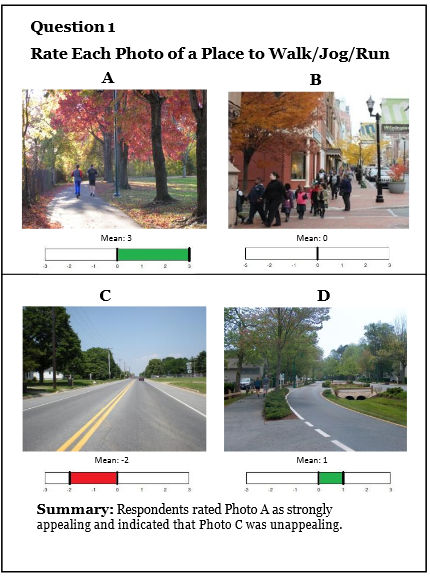
Results from The City of Milford’s Visual Preference Survey
Successful high-touch engagement initiatives give citizens the tools they need to express their concerns and ideas. Visual preference surveys, windshield/walking surveys, charrettes, and world café sessions are examples of techniques that local governments can employ to achieve this result.
A visual preference survey (VPS) helps citizens, decision-makers, and other stakeholders determine preferences for various types of community design, architectural styles, land-/streetscaping, and/or built-environment options. A VPS allows participants to view and rate visual aspects of, and preferences for community design images (either existing or proposed). Participants rate each image based on its visual appeal and results are tabulated. As both a visualization technique and public engagement tool, a VPS gives citizens the opportunity to provide public input as a factor in decision-making on community design components that may impact land-use patterns, transportation options, the built environment, and/or site design features. A similar technique is to hold a public session where community members are invited to take pictures of public spaces that they like, as well as those they see as less desirable. The results of this exercise are then presented in a public forum setting.
Windshield and walking surveys allow facilitators and stakeholders to observe the environment of a community in the way that most community members experience it. Small groups of participants either drive or walk around the community depending on what features are to be assessed. The group’s facilitator leads discussion, notes the group’s comments, and reports back to relevant decision makers. Windshield and walking surveys are often used at the onset of a planning process to map or identify community assets, conduct a Strengths, Weaknesses, Opportunities, and Threats (SWOT) analysis, or assess community issues on a first-hand basis.
A charrette is a form of collaborative planning that educates citizens on upcoming projects, and invites them to share their ideas. Charrettes are held during the pre-design phase of a project, and help steer the decisions of project designers. At the conclusion of the charrette, designers present final project options to the participants. The National Charrette Institute provides resources, training, publications, and project consulting services for interested jurisdictions.
The World Café method circulates participants through a series of tables where different questions are discussed. Participants record their own feedback and participate in discussion. At the end of the session, results of the discussion are summarized as a large group.
There are many high-touch public engagement strategies, and any of them can be successful if a wide variety of community members are invited to join in the process of planning the future of their community.
High-Tech Public Engagement
Online networks are growing and evolving. Computers, smartphones and tablets offer convenient access to these online spaces and allow busy people to connect. As a result, ‘high-tech’ tools can be used to expand public involvement in planning.
There are many online tools that can be used to encourage public engagement. These include: Website Features, Social Media Platforms, Mobile Apps, GIS Applications.
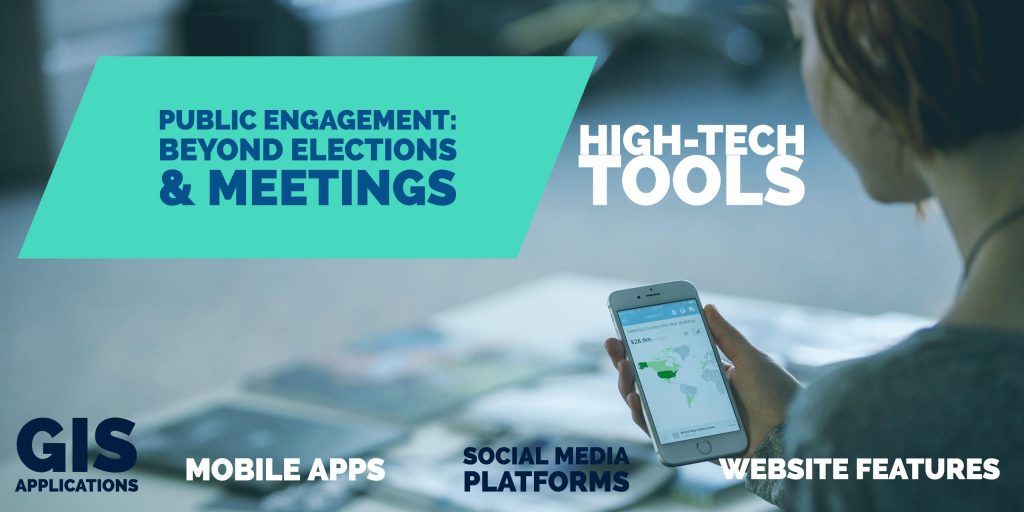
Website Features
User-friendly local government websites are invaluable as they support governmental efficiency and service delivery. Online bill pay, access to forms/codes, community calendars, and links to non-emergency requests for service, and other pertinent information give citizens better access to government services electronically. The Center for Digital Government annually awards city, county and state governments for outstanding portals and websites based on innovation, functionality, productivity and performance.
Social Media
Social media offers fast, easy, affordable access to established communities and diverse communications tools. Using social media yields worthwhile rewards such as increased event registration, improved data quality, and strengthened stakeholder relationships.

Source: Get Engaged
Variety is the key to success according to Creating the Social Media Game Plan. Local leaders can reach the broadest network of citizens by creating an online presence in several of the following categories.
Social networks can be used to transmit brief messages along personal or local networks. News Feeds (blogs, RSS feeds) offer regular delivery of polished content to subscribers. Visual/Audio Media platforms (YouTube, Vimeo, podcasting) distribute graphics, video and sound files. Data-gathering accounts (Google Analytics or CitizenScape) collect, analyze and display online data.
Mobile Apps
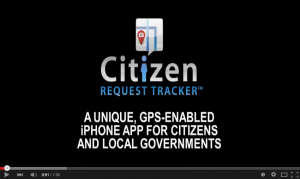
Click the image above for more information about the Citizen Request Tracker App. Source: CivicPlus
Smartphone use is becoming ubiquitous in the United States. This provides an opportunity for local governments to use mobile apps as a way to respond to the needs and concerns of their citizens in real time. A Government Technology article on “Building Additive Mobile Apps for Citizens and Employees” cites examples of cities, like Philadelphia, that are using 311 apps. Citizens and visitors can use this form of mobile technology to report issues such as broken meters or potholes, submit photos of graffiti or abandoned vehicles, track local buses, and browse listings for local events. for citizens to report problems, such as potholes, and submit pictures of graffiti or abandoned vehicles that need to be removed. Users get an immediate acknowledgement that the city has received their request, and they can track progress on resolving the issue. Other cities are using mobile apps to better manage municipal parking by allowing drivers to select parking facilities, view directions and pay for parking on their devices. The Delaware Department of Transportation has recently seen success with its DelDOT App, a real-time traveler information system, which advises travelers to travel delays, road conditions, and estimated travel times among other capabilities.
GIS Applications
Visit the Implementing Complete Communities GIS Gallery to see examples of story maps that enhance policy and planning on the local level.
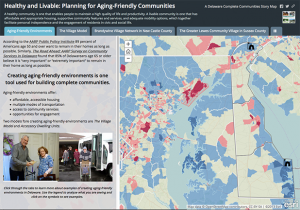
Story maps support place based public engagement through statistical analysis, mapping, crowdsourcing, and more.
Many of the features of mobile apps feature GIS connectivity, providing app administrators with the locations of reported problems. GIS applications can also be used create story maps, identify community assets, and to effectively illustrate a community’s zoning restrictions.
An Integrated Approach to Public Engagement
Incorporating both “high-tech” and “high-touch” elements into public engagement strategies enables governments and government organizations to provide a high level of service to diverse audiences, and recent technological advancements are making it easier than ever to use this method of public engagement.
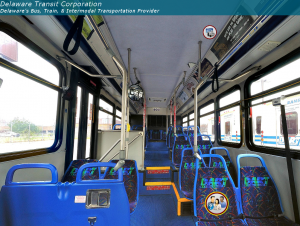
Click the image above for a digital tour of a DART bus. Source: DART
The Town of Smyrna’s August 2012 Design Week, is a good example of an integrated approach to public engagement. Planners gathered data, made forecasts, and promoted early input with traditional PR, flyers, and online publicity. Next, online surveys and stakeholder interviews collected citizen input on a new community vision statement and proposal revisions. Finally, during the five-day charrette, residents and planners collaborated, discussed pros and cons, identified potential solutions, and finalized the plan.
DART First State uses high-tech and high-touch methods to connect with the citizens who depend on their services. DART’s webpage uses photo headers that link to Google Transit Maps of routes, virtual tours of DART sites and vehicles, and how-to videos. Citizens can stay connected to vital information by using social media, subscribing to the site’s RSS feed, or registering for text message alerts. These measures are all in addition to in-person bus rider surveys, public hearings and workshops held at locations across the state.
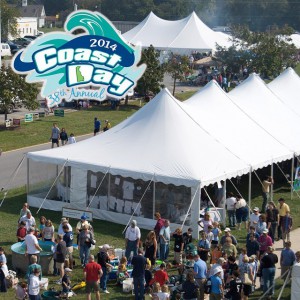
Source: Sea Grant Delaware
SeaGrant Delaware is another local example of an organization that has seen the success of an integrated approach to public engagement. Its website hosts many outreach features including an events calendar, event registration, online newsletter, PDFs of reports, and a news archive. To engage with residents on an interpersonal basis, communities receive workshops and training on land use and community planning specific to the needs of coastal environments. SeaGrant also uses its annual Coast Day event to engage and educate the community. Coast Day showcases the work of scientists studying Delaware’s marine environment, and offers attendees of all ages’ fun, educational marine-related activities. Coast Day’s storify page extends the event’s outreach potential by documenting the even for those unable to attend.
Combining “high-tech” and “high-touch” elements expands the reach of public engagement initiatives, linking communities to the organizations that serve them.
Best Practices
There are many examples of innovative public engagement strategies in the State of Delaware.
Videos
The Dover/Kent County MPO’s Virtual Video Tour of 2014 Transportation Improvement Plan (TIP) projects includes instructions and an overview of TIP features, clickable map pins on a Google map, and video tours of eleven sites.
Workshops
WILMAPCO offers free, interactive Walkable Community Workshops for New Castle County communities interested in improving their pedestrian routes. Workshop participants learn about assessing walkability, take a walking tour of the study area, and identify priorities and methods to make local pedestrian thoroughfares safer and more convenient.
The video below, developed by Lee Ann Walling in partnership with WILMAPCO, shows the walkable community workshop process.
DelDOT holds both regular and virtual public workshops for public updates and feedback on transportation projects. A virtual public workshop is a Web page that includes information about a proposed transportation project with an added bonus—the public is able to submit a project‐specific questionnaire or survey directly online. As per the Americans with Disabilities Act, DelDOT accommodates persons with disabilities and other special needs at workshops.
When new codes were needed in Bethany Beach on residential renewable energy use, planners mailed out a survey, received ample community feedback, and drafted three ordinances in all. These drafts were then reviewed and revised line-by-line at workshops for industry stakeholders and interested citizens. The resulting ordinances were met with widespread approval.
Over 18 months, the City of Newark’s Comprehensive Plan Review has involved outreach, public information, visioning sessions, open houses and workshops on housing, transportation, neighborhoods, land use and economic development. The culmination of public involvement in the planning process is the City Council’s adoption of the Comprehensive Development Plan V.
Apps and Websites
The City of Newark website features downloadable apps for residents. The Citizen Request Tracker allows users to send the city photographs, GPS locations and text descriptions of issues, and then track the city’s response
The City of Dover‘s website features a community calendar, connections to city social media, newsletters, and RSS feeds. At the website’s Citizen Action Center, visitors can ask questions, find answers, make requests, and track their interactions with government. These features can promote public engagement efforts such as Dover’s 2010 charrette.
The City of Wilmington’s Report It, Resolve It app allows residents to use their mobile devices to submit a non-emergency request for service (e.g., pothole), or complaint to be resolved by the Public Works Department.
Delaware’s Government Information Center is developing eGovernment apps for mobile device and computer use. Users of the Delaware State Parks app can search a state parks database, access quick-reference maps, record data during park visits (photos, waypoint markers, and routes), and easily reach park staff.
Visualization Tools
Several initiatives at the University of Delaware use GIS tools for public engagement. The Sustainable Coastal Communities Initiative uses Community Viz to analyze, map, model and present data for planning workshops and projects.
The Delaware Sea Grant College Program uses we Table for participatory mapping at public forums.
Social Media
Delaware state agencies and departments are active on social media. On Twitter and Facebook, DNREC and the DDA transmit an appealing mixture of announcements, graphics, and links. Other notable accounts include Economic Development’s Flickr album, DelDOT’s YouTube account, and the Geographic Data Committee’s blog.
Towns in Delaware have also joined social media. 12,500 people see posts on the Rehoboth Beach Facebook or Twitter feeds, and the Downtown Newark Partnership connects on Twitter and Facebook to 1,600 followers. These towns typically post visuals and brief text messages a few times a week to promote local businesses, events, meetings, and achievements.
Tools and Resources for Public Engagement
Bubbl is an easy-to-use platform for collaborative brain storming and mind mapping.
Doodle is a scheduling tool perfect for making public hearings and workshops visible on an online calendar.
Toolstoengage is devoted to showcasing the many tools planners and local governments can employ for the purpose of public engagement.
GovLoop is the “Knowledge Network for Government.” It is the premier social network connecting over 150,000 federal, state, and local government innovators. GovLoop curates a newsletter and houses useful articles on a variety of common issues facing local governments. The site picks up the best articles from a variety of sources and compiles them onto top-centered web pages. This site is perfect for staying up to date on the latest trends.
Governing Magazine (crowd sourcing)
This article discusses crowdsourcing in the public sector as a method to engage an online community to identify or develop innovative solutions to public problems. Crowdsourcing uses a mix of a traditional top-down, hierarchical process with a bottom-up, grass roots approach via online methods. Many state and local governments are using crowdsourcing initiatives to engage the public, and provide better services by leveraging the knowledge of the community online.
CommunityMatters® is a program of the Orton Family Foundation, which seeks to empower people to shape the future of their communities through the Community Heart & Soul method of community development. Community Matters disseminates information on a variety of disciplines related to local governance via its blog, conference calls, and an e-newsletter. One area of focus for the organization is improving the civic engagement efforts of local governments.
Engaging Cities is an online magazine that shares creative strategies and new technologies to foster public engagement for livable communities.
Granicus is a package of online community engagement tools. These tools give citizens greater means to communicate with their public officials, and also help officials manage the input they receive. Other benefits include integration with social media sites and data analytics.
Delaware Resources
Delaware Office of State Planning Coordination
The Office of State Planning Coordination (OSPC) works to improve the coordination and effectiveness of land use decisions made by state, county, and municipal governments while building and maintaining a high quality of life in the State of Delaware. OSPC provides a wide range of planning assistance to local governments through its “circuit-rider planners.”
Delaware Department of Transportation
The Delaware Department of Transportation (DelDOT) strives to achieve excellence in transportation through public outreach activities that result in an open, meaningful, and informative interaction among its stakeholders. DelDOT uses a combination of high-touch, high-techniques, to engage and inform Delawareans about transportation-related projects and programs. It provides an annual customer service survey, in-person and virtual workshops, a DelDOT App with real time information for Delaware roadways, interactive information via social media, and live video feeds for Division of Motor Vehicles wait times.
Dover/Kent County Metropolitan Planning Organization
The Dover/Kent County MPO is the federally-designated agency responsible for coordinating transportation planning and programming in Kent County, Delaware, including all of Milford and Smyrna. Links to more information on its projects and programs that engage the public can be found on its website.
State of Delaware Government Information Center
The State of Delaware’s Government Information Center provides assistance to local governments, including designing and hosting some local government websites and hosting and leading a Municipal Web Developer’s Group to foster inter-governmental discussion and collaboration.
As an engaged university, the University of Delaware work closely with public agencies throughout the state, applying research and human talent to address pressing social and civic issues. More than 70 research centers and institutes across the UD campus reflect the diversity and rigor of its research activity and commitment to improving the quality of life in Delaware and beyond.
For example, the Institute for Public Administration (IPA), within the School of Public Policy and Administration, offers programs, training, and resources to build capacity of Delaware local government officials. The IPA’s online Delaware Complete Communities Planning Toolbox provides a video that examines community engagement techniques in the digital age. This video explores the nexus for public participation in community planning, the difference between high-tech and high-touch engagement strategies, and case study examples from planning organizations in the region. IPA’s Delaware Planning Education Program provides educational courses designed to meet the responsibilities of municipalities as partners in the state’s strategies for policies and spending initiative. IPA’s Conflict Resolution Program (CRP) is a resource center dedicated to supporting transformational and organizational change in nonprofit, public, government, and educational settings. CRP provides training, facilitates meetings, and promotes effective communication, collaborative problem-solving, organizational development, and alternative dispute resolution.
UD’s Sustainable Coastal Communities Initiative is an approach to address growth, land use, and environmental impacts in southern Delaware. Its website provides tools and visualization techniques for engaging communities and stakeholders in planning for the specific needs of coastal communities.
The Wilmington Area Planning Organization believes that a core feature of its mission is public outreach. The following links illustrate the breadth of their work with the public.
- Air Quality Partnership of Delaware
- Public Participation Plan
- Transportation Planning Guide
- Surveys
- Our Town
- School Program
- Emergency Preparedness
National Resources
The Alliance for Innovation’s focus is discovering ways for local governments to adopt innovative practices. Its website has details on these practices as well as a question-and-answer tool so that government officials can get input from others or share their experiences.
International City/County Management Association
ICMA’s mission is to create excellence in local governance by developing and fostering professional management to build better communities. It is committed to providing the best resources for public engagement to local leaders. Its website has up-to-date links, resources, and tools, all explained in digestible language. ICMA’s Knowledge Network provides and informative report on Public Pathways: A Guide to Online Engagement for Local Gov Leaders. It analyzes 20 online tools that are being used by local governments across the nation. The report also provides feedback from local government leaders on what works, and how to build a framework for evaluating the success of any new public engagement tool or strategy.
ICMA’s National Citizen Survey is designed for use by local governments to obtain citizen feedback. It’s customizable, so when presented to citizens, it asks them questions relevant to their specific community. The results measure public opinion in eight key areas of livability that help government officials make meaningful changes in their communities.
The National Charrette Institute offers trainings and additional information for community leaders wishing to conduct charrettes in their own communities.
The NLC puts its focus squarely on regional and local governments. Its website shares innovative ideas, summarizes the latest research into short articles, and provides detailed examples of how municipalities have overcome challenges in public engagement.
U.S. Department of Transportation
The U.S. Department of Transportation’s website lists and explains best practices for informing the public through outreach and organization. This resource also gives specific suggestions for tailoring public engagements to populations typically undeserved by the process.

